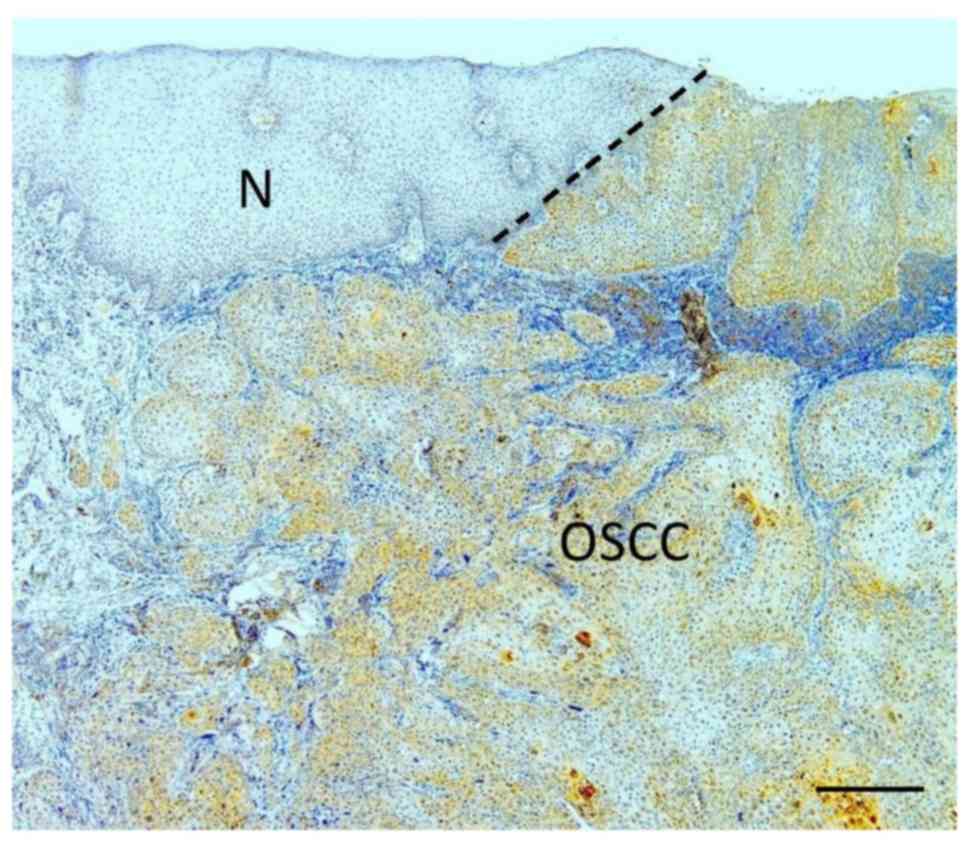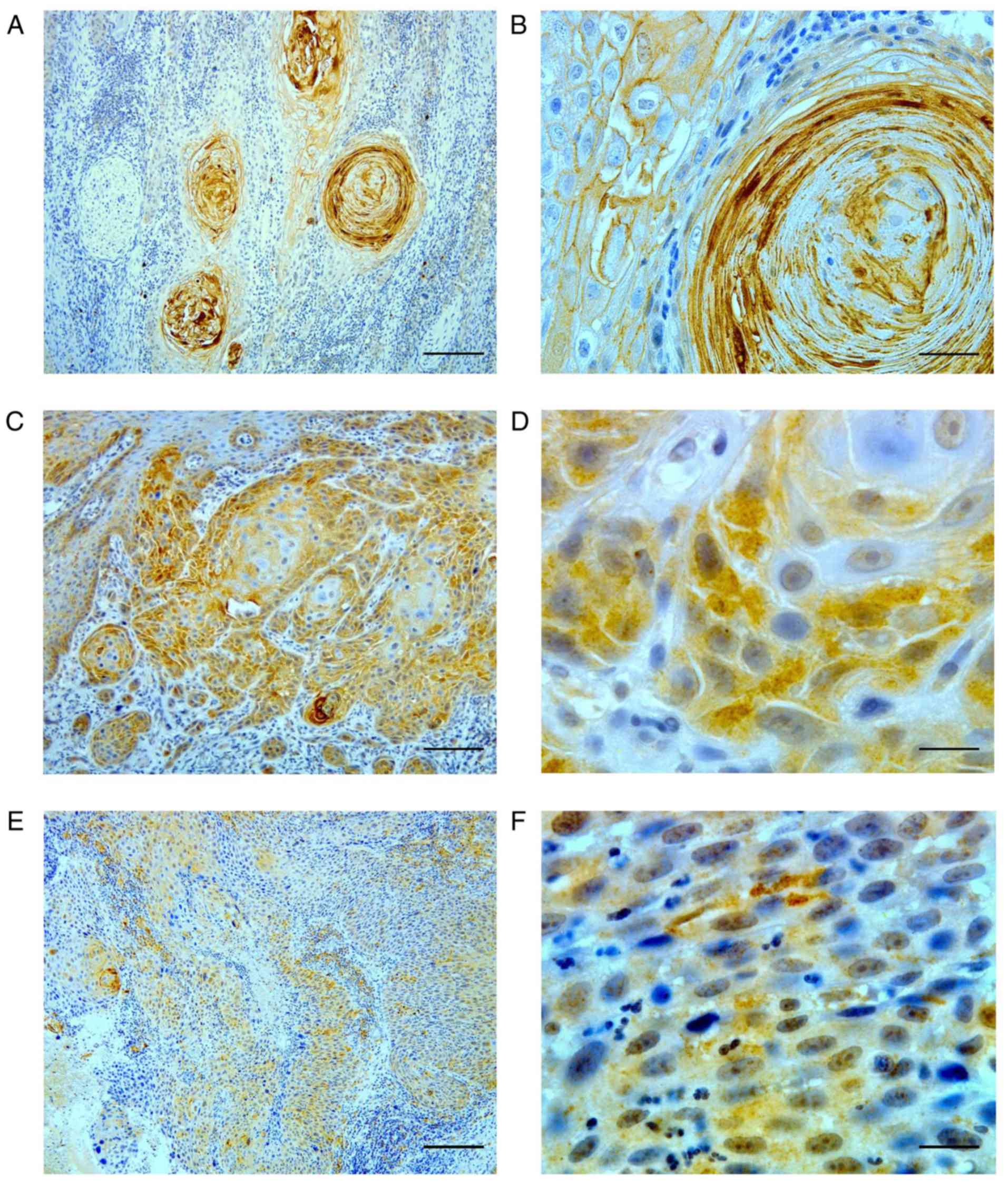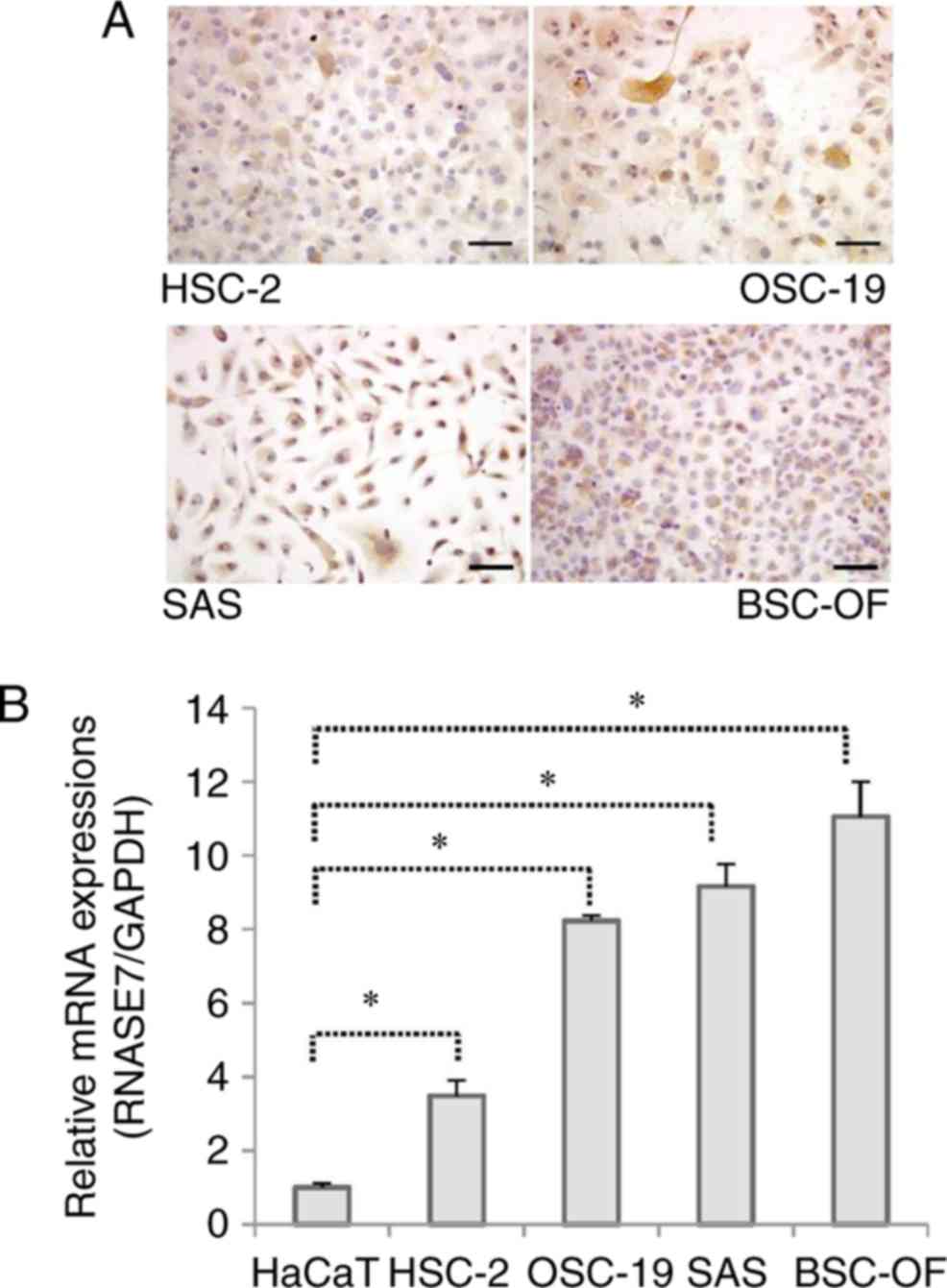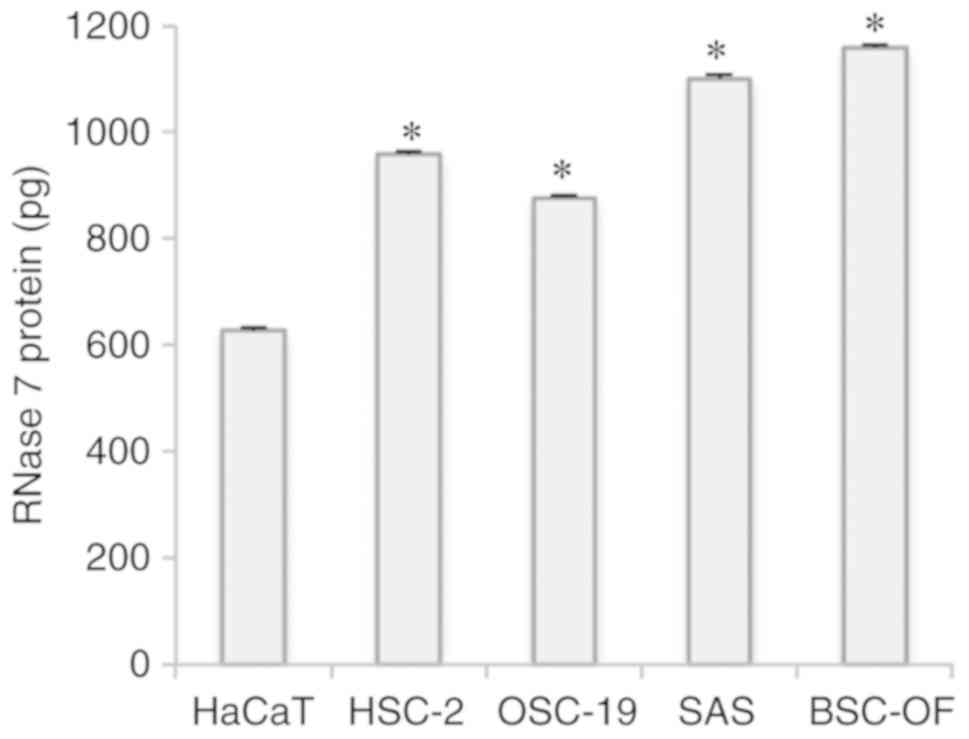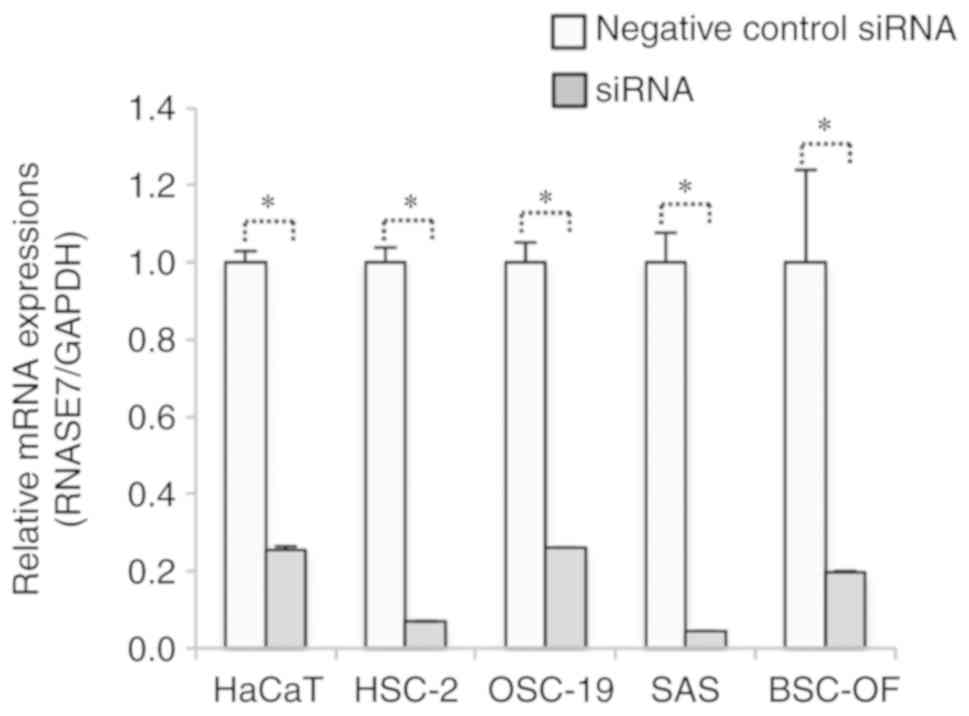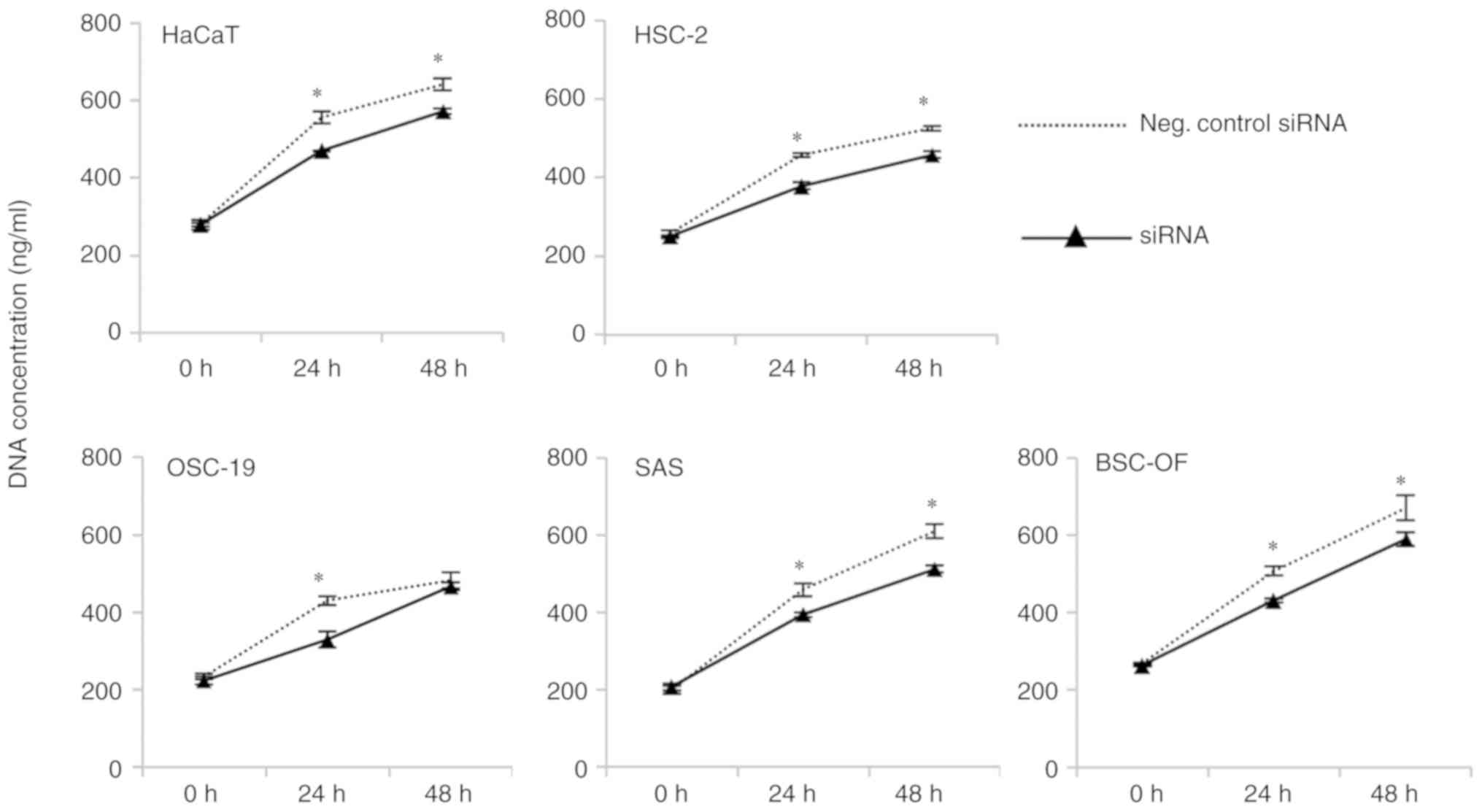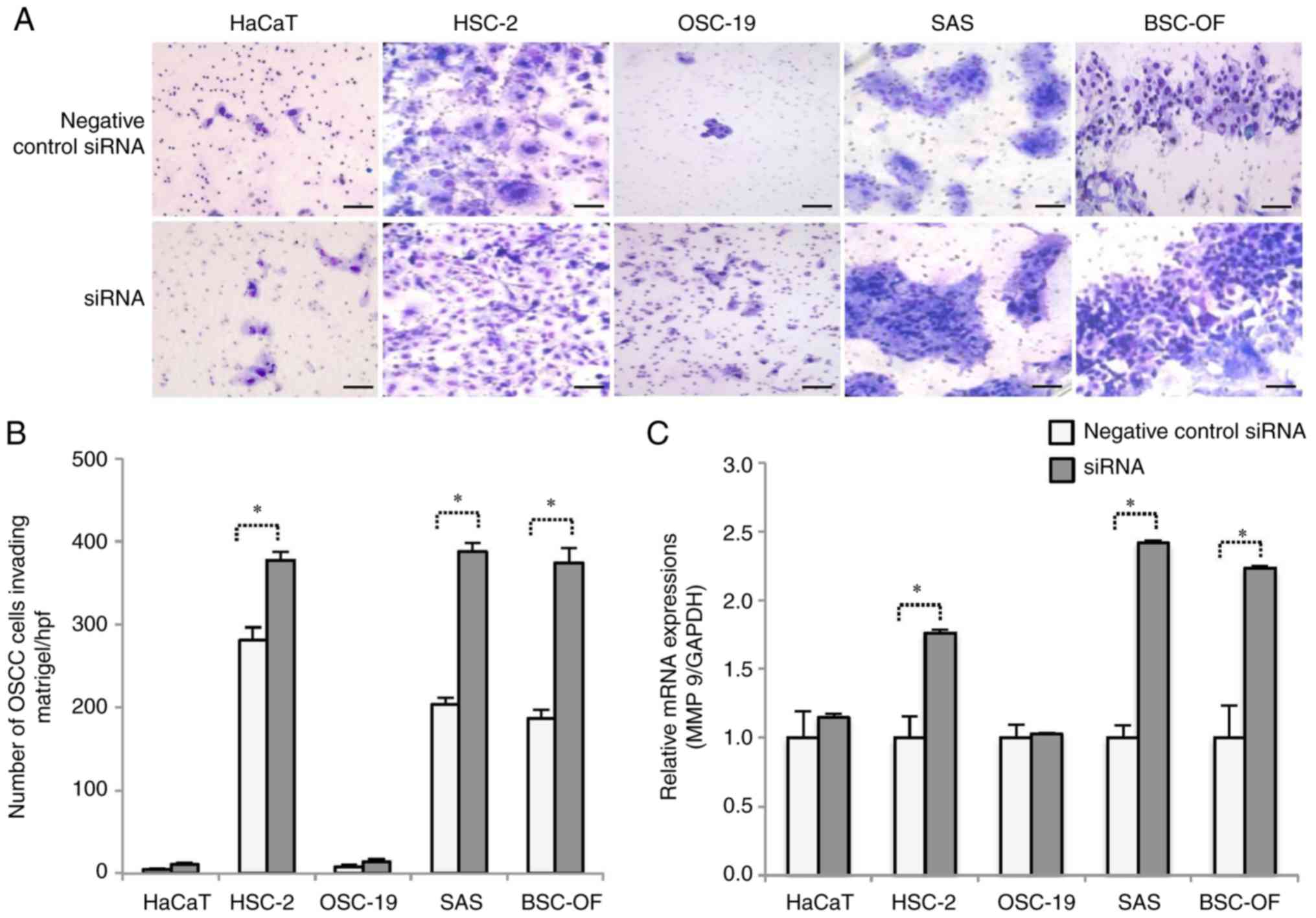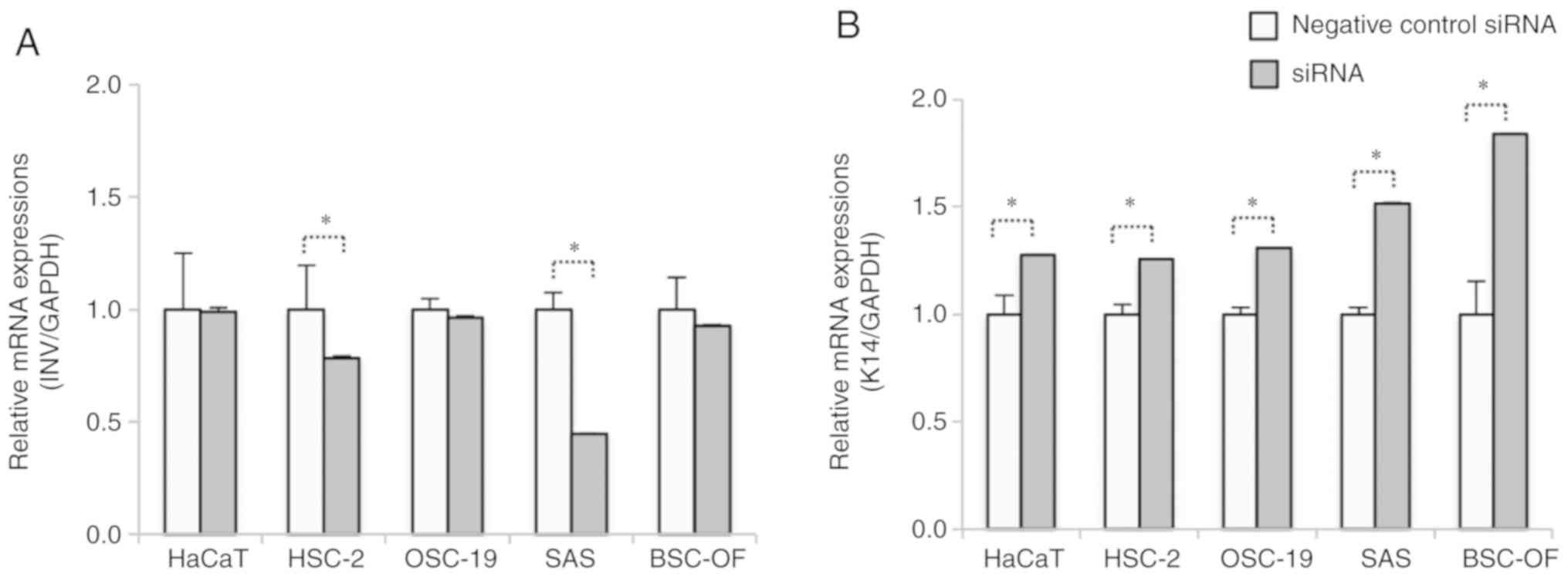|
1
|
Harder J and Schroder JM: RNase 7, a novel
innate immune defense antimicrobial protein of healthy human skin.
J Biol Chem. 277:46779–46784. 2002. View Article : Google Scholar : PubMed/NCBI
|
|
2
|
Spencer JD, Schwaderer AL, Dirosario JD,
McHugh KM, McGillivary G, Justice SS, Carpenter AR, Baker PB,
Harder J and Hains DS: Ribonuclease 7 is a potent antimicrobial
peptide within the human urinary tract. Kidney Int. 80:174–180.
2011. View Article : Google Scholar : PubMed/NCBI
|
|
3
|
Amatngalim GD, Broekman W, Daniel NM, van
der Vlugt LE and Hiemstra PS: Cigarette smoke impairs basal cell
mediated epithelial wound repair and induces expression of the
antimicrobial protein RNase 7 via oxidative stress. Eur Respir J.
46 (Suppl 59):PA50472015.
|
|
4
|
Eberhard J, Menzel N, Dommisch H, Winter
J, Jepsen S and Mutters R: The stage of native biofilm formation
determines the gene expression of human beta-defensin-2, psoriasin,
ribonuclease 7 and inflammatory mediators: A novel approach for
stimulation of keratinocytes with in situ formed biofilms. Oral
Microbiol Immunol. 23:21–28. 2008. View Article : Google Scholar : PubMed/NCBI
|
|
5
|
Köten B, Simanski M, Gläser R, Podschun R,
Schröder JM and Harder J: RNase 7 contributes to the cutaneous
defense against enterococcus faecium. PLoS One. 4:e64242009.
View Article : Google Scholar : PubMed/NCBI
|
|
6
|
Simanski M, Dressel S, Gläser R and Harder
J: RNase 7 protects healthy skin from staphylococcus aureus
colonization. J Invest Dermatol. 130:2836–2848. 2010. View Article : Google Scholar : PubMed/NCBI
|
|
7
|
Weinberg A, Jin G, Sieg S and McCormick
TS: The yin and yang of human beta-defensins in health and disease.
Front Immunol. 3:2942012. View Article : Google Scholar : PubMed/NCBI
|
|
8
|
Ghosh SK, McCormick TS and Weinberg A:
Human beta defensins and cancer: Contradictions and common ground.
Front Oncol. 9:3412019. View Article : Google Scholar : PubMed/NCBI
|
|
9
|
Liu Y, Bunston C, Hodson N, Resaul J, Sun
PH, Cai S, Chen G, Gu Y, Satherley LK, Bosanquet DC, et al:
Psoriasin promotes invasion, aggregation and survival of pancreatic
cancer cells; association with disease progression. Int J Oncol.
50:1491–1500. 2017. View Article : Google Scholar : PubMed/NCBI
|
|
10
|
Algermissen B, Sitzmann J, LeMotte P and
Czarnetzki B: Differential expression of CRABP II, psoriasin and
cytokeratin 1 mRNA in human skin diseases. Arch Dermatol Res.
288:426–430. 1996. View Article : Google Scholar : PubMed/NCBI
|
|
11
|
Chen X, Zou X, Qi G, Tang Y, Guo Y, Si J
and Liang L: Roles and mechanisms of human cathelicidin LL-37 in
cancer. Cell Physiol Biochem. 47:1060–1073. 2018. View Article : Google Scholar : PubMed/NCBI
|
|
12
|
Kahlenberg JM and Kaplan MJ: Little
peptide, big effects: The role of LL-37 in inflammation and
autoimmune disease. J Immunol. 191:4895–4901. 2013. View Article : Google Scholar : PubMed/NCBI
|
|
13
|
Ross KF and Herzberg MC: Calprotectin
expression by gingival epithelial cells. Infect Immun.
69:3248–3254. 2001. View Article : Google Scholar : PubMed/NCBI
|
|
14
|
Scola N, Gambichler T, Saklaoui H, Bechara
FG, Georgas D, Stücker M, Gläser R and Kreuter A: The expression of
antimicrobial peptides is significantly altered in cutaneous
squamous cell carcinoma and precursor lesions. Br J Dermatol.
167:591–597. 2012. View Article : Google Scholar : PubMed/NCBI
|
|
15
|
Abiko Y, Okumura K, Ohuchi T, Konishi T,
Kanazawa M and Kaku T: Basaloid-squamous cell carcinoma of the
floor of the mouth: Characterization of a cell line. J Oral Pathol
Med. 26:367–370. 1997. View Article : Google Scholar : PubMed/NCBI
|
|
16
|
Livak KJ and Schmittgen TD: Analysis of
relative gene expression data using real-time quantitative PCR and
the 2(-Delta Delta C(T)) method. Methods. 25:402–408. 2001.
View Article : Google Scholar : PubMed/NCBI
|
|
17
|
Neopane P, Paudel D, Yoshida K, Raj
Adhikari B, Morikawa T, Onishi A, Hiraki D, Uehara O, Sato J,
Nishimura MA, et al: Immunohistochemical localization of RNase 7 in
normal and inflamed oral epithelia and salivary glands. Acta
Histochem Cytochem. 52:35–43. 2019. View Article : Google Scholar : PubMed/NCBI
|
|
18
|
Abiko Y, Suraweera AK, Nishimura M,
Arakawa T, Takuma T, Mizoguchi I and Kaku T: Differential
expression of human beta-defensin 2 in keratinized and
non-keratinized oral epithelial lesions; immunohistochemistry and
in situ hybridization. Virchows Arch. 438:248–253. 2001. View Article : Google Scholar : PubMed/NCBI
|
|
19
|
Pushalkar S, Ji X, Li Y, Estilo C,
Yegnanarayana R, Singh B, Li X and Saxena D: Comparison of oral
microbiota in tumor and non-tumor tissues of patients with oral
squamous cell carcinoma. BMC Microbiol. 12:1442012. View Article : Google Scholar : PubMed/NCBI
|
|
20
|
Grandis JR and Tweardy DJ: TGF-alpha and
EGFR in head and neck cancer. J Cell Biochem Suppl. 17F:188–191.
1993. View Article : Google Scholar : PubMed/NCBI
|
|
21
|
Sheikh Ali MA, Gunduz M, Nagatsuka H,
Gunduz E, Cengiz B, Fukushima K, Beder LB, Demircan K, Fujii M,
Yamanaka N, et al: Expression and mutation analysis of epidermal
growth factor receptor in head and neck squamous cell carcinoma.
Cancer Sci. 99:1589–1594. 2008. View Article : Google Scholar : PubMed/NCBI
|
|
22
|
Kamino Y, Kurashige Y, Uehara O, Sato J,
Nishimura M, Yoshida K, Arakawa T, Nagayasu H, Saitoh M and Abiko
Y: HBD-2 is downregulated in oral carcinoma cells by DNA
hypermethylation, and increased expression of hBD-2 by DNA
demethylation and gene transfection inhibits cell proliferation and
invasion. Oncol Rep. 32:462–468. 2014. View Article : Google Scholar : PubMed/NCBI
|
|
23
|
Sun CQ, Arnold R, Fernandez-Golarz C,
Parrish AB, Almekinder T, He J, Ho SM, Svoboda P, Pohl J, Marshall
FF and Petros JA: Human beta-defensin-1, a potential chromosome 8p
tumor suppressor: Control of transcription and induction of
apoptosis in renal cell carcinoma. Cancer Res. 66:8542–8549. 2006.
View Article : Google Scholar : PubMed/NCBI
|
|
24
|
Tsujikawa T, Yaguchi T, Ohmura G, Ohta S,
Kobayashi A, Kawamura N, Fujita T, Nakano H, Shimada T, Takahashi
T, et al: Autocrine and paracrine loops between cancer cells and
macrophages promote lymph node metastasis via CCR4/CCL22 in head
and neck squamous cell carcinoma. Int J Cancer. 132:2755–2766.
2013. View Article : Google Scholar : PubMed/NCBI
|
|
25
|
Kesting MR, Loeffelbein DJ, Hasler RJ,
Wolff KD, Rittig A, Schulte M, Hirsch T, Wagenpfeil S, Jacobsen F
and Steinstraesser L: Expression profile of human beta-defensin 3
in oral squamous cell carcinoma. Cancer Invest. 27:575–581. 2009.
View Article : Google Scholar : PubMed/NCBI
|
|
26
|
Yoshimoto T, Yamaai T, Mizukawa N, Sawaki
K, Nakano M, Yamachika E and Sugahara T: Different expression
patterns of beta-defensins in human squamous cell carcinomas.
Anticancer Res. 23:4629–4633. 2003.PubMed/NCBI
|
|
27
|
Abiko Y, Mitamura J, Nishimura M,
Muramatsu T, Inoue T, Shimono M and Kaku T: Pattern of expression
of beta-defensins in oral squamous cell carcinoma. Cancer Lett.
143:37–43. 1999. View Article : Google Scholar : PubMed/NCBI
|
|
28
|
Sawaki K, Mizukawa N, Yamaai T, Yoshimoto
T, Nakano M and Sugahara T: High concentration of beta-defensin-2
in oral squamous cell carcinoma. Anticancer Res. 22:2103–2107.
2002.PubMed/NCBI
|
|
29
|
Björklund M and Koivunen E:
Gelatinase-mediated migration and invasion of cancer cells.
Biochim. Biochim Biophys Acta. 1755:37–69. 2005.PubMed/NCBI
|
|
30
|
Egeblad M and Werb Z: New functions for
the matrix metalloproteinases in cancer progression. Nat Rev
Cancer. 2:161–174. 2002. View
Article : Google Scholar : PubMed/NCBI
|
|
31
|
Bullock S and Hales M: Neoplasia. Babey
AM: Principles of pathophysiology, chapter 4. Pearson Higher
Education AU; pp. 662012
|
|
32
|
Alam H, Sehgal L, Kundu ST, Dalal SN and
Vaidya MM: Novel function of keratins 5 and 14 in proliferation and
differentiation of stratified epithelial cells. Mol Biol Cell.
22:4068–4078. 2011. View Article : Google Scholar : PubMed/NCBI
|
|
33
|
Eichler TE, Becknell B, Easterling RS,
Ingraham SE, Cohen DM, Schwaderer AL, Hains DS, Li B, Cohen A,
Metheny J, et al: Insulin and the phosphatidylinositol 3-kinase
signaling pathway regulate ribonuclease 7 expression in the human
urinary tract. Kidney Int. 90:568–579. 2016. View Article : Google Scholar : PubMed/NCBI
|
|
34
|
Wang Y, Wan D, Zhou R, Zhong W, Lu S and
Chai Y: Geraniin inhibits migration and invasion of human
osteosarcoma cancer cells through regulation of PI3K/Akt and ERK1/2
signaling pathways. Anticancer Drugs. 28:959–966. 2017. View Article : Google Scholar : PubMed/NCBI
|
|
35
|
Guo LY, Li YM, Qiao L, Liu T, Du YY, Zhang
JQ, He WT, Zhao YX and He DQ: Notch2 regulates matrix
metallopeptidase 9 via PI3K/AKT signaling in human gastric
carcinoma cell MKN-45. World J Gastroenterol. 18:7262–7270. 2012.
View Article : Google Scholar : PubMed/NCBI
|
|
36
|
Kobayashi T, Hattori S, Nagai Y and Tajima
S: Differential regulation of the secretions of matrix
metalloproteinase-9 and tissue inhibitor of metalloproteinases-1
from human keratinocytes in culture. IUBMB Life. 50:221–226. 2000.
View Article : Google Scholar : PubMed/NCBI
|
|
37
|
O-charoenrat P, Modjtahedi H, Rhys-Evans
P, Court WJ, Box GM and Eccles SA: Epidermal growth factor-like
ligands differentially up-regulate matrix metalloproteinase 9 in
head and neck squamous carcinoma cells. Cancer Res. 60:1121–1128.
2000.PubMed/NCBI
|















